If you’ve been wanting to tattoo yourself but don’t know how, this guide is for you! This step-by-step guide will show you how to tattoo yourself with a tattoo gun safely and effectively. We’ll cover everything from choosing the right equipment and supplies, to setting up the tattoo gun and executing the tattoo. By the end of this guide, you’ll know exactly how to tattoo yourself with a tattoo gun. So let’s get started!
Contents
Benefits of Tattooing Yourself with a Tattoo Gun
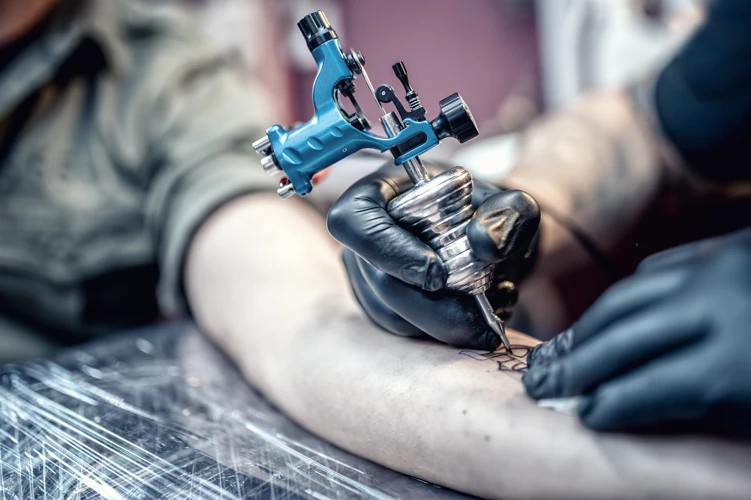
- Complete Control: Tattooing yourself with a tattoo gun allows you to have complete control over the design and placement of the tattoo.
- Affordability: Tattooing yourself with a tattoo gun is a much more affordable option than going to a professional tattoo parlor.
- Personalized: With a tattoo gun, you can create a unique and personalized design that will be unique to you.
- Self-expression: Tattooing yourself with a tattoo gun is an excellent way to express yourself and your individuality.
- Convenience: Tattooing yourself with a tattoo gun is a much more convenient option than having to travel to a professional tattoo parlor.
If you are looking for a way to get a tattoo without the added expense of going to a professional tattoo artist, you may want to consider tattooing yourself with a tattoo gun. Not only is the process much more affordable, but it also allows you to have complete control over the design and placement of the tattoo. Plus, you can create a unique and personalized design that will be unique to you and allow you to express yourself and your individuality. So, if you are looking for a way to get a tattoo without breaking the bank, a tattoo gun may be just the thing for you.
Preparing Yourself to Tattoo
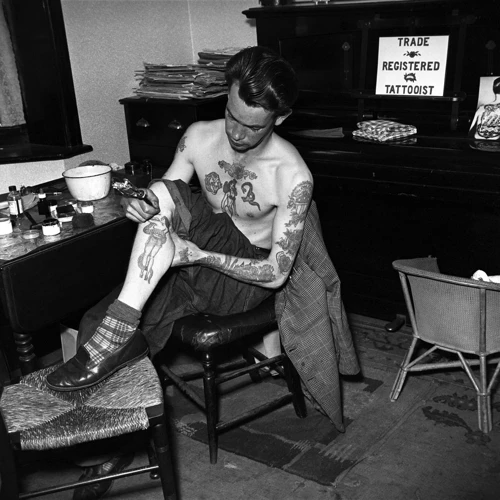
Gather Your Supplies
Before you begin tattooing, make sure you have all the necessary supplies. You will need a tattoo gun, a power source for the gun, needles, ink, a work station, and a variety of other supplies such as stencils, rubber bands, and gloves.
Choose Your Design
Choose a design that is meaningful to you and that you will be proud to wear for the rest of your life. Take your time to find the right design and ensure that you are happy with it before you proceed.
Sanitize the Area
It is essential to sanitize the area where you will be tattooing, as well as all your supplies. This is to prevent the spread of infection and disease. Start by cleaning the skin with a disinfectant, then apply a thin layer of petroleum jelly to the area. This will make it easier to insert the needles into the skin. Once you have sanitized the area and your supplies, you are ready to begin tattooing yourself with a tattoo gun.
Instructions for Tattooing Yourself with a Tattoo Gun
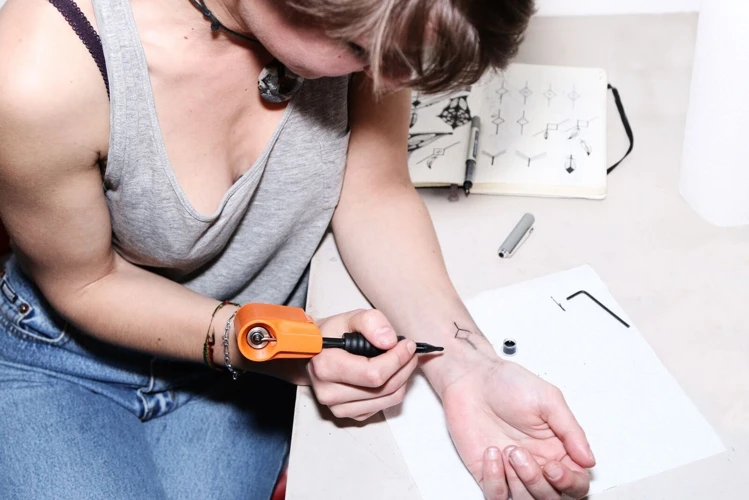
Connect the Gun and Test the Needles
Connect the power cord and clip cord to the gun and plug them into the power source. Make sure the power switch is off before connecting. Test the needle by turning the power switch on and off. Be sure to use gloves and face mask for safety.
Choose Your Ink Color
Choose the color of ink you want to use. It is important to use organic, vegan-friendly, non-toxic ink.
Place the Needles in the Gun
Place the needles into the gun, making sure they are securely in place. Be sure to use a new, sterile needle for each tattoo.
Start Tattooing
Start by pressing down on the gun and gently moving it over the area you are going to tattoo. Be sure to keep the gun at a consistent distance from your skin. When you are finished, carefully remove the gun and clean the area with antiseptic.
Now you know how to give yourself a tattoo with a gun. Be sure to take your time and go slowly. With the right tools and technique, you can create beautiful, professional looking tattoos.
Instructions for Tattooing Yourself without a Gun
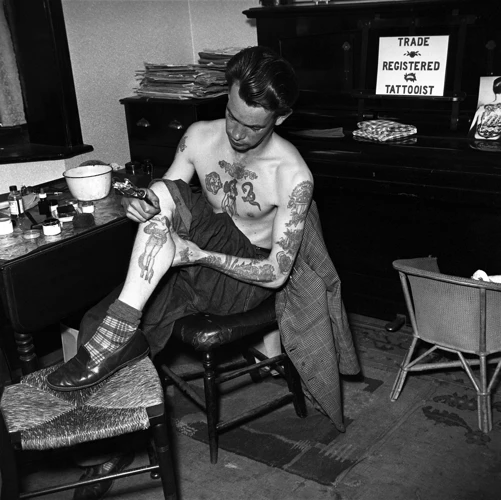
Preparing Your Equipment
Gather the necessary supplies: gloves, sterilized needles, rubbing alcohol, paper towels, and a clean, flat surface. Make sure that all of the supplies are sterile and ready to use.
Choose Your Design
Pick a design that you love and can commit to for life. Think carefully about the size, shape, and placement of the tattoo.
Sanitize the Area
Clean the area with rubbing alcohol, then cover it with a thin layer of petroleum jelly. Make sure that the area is completely clean and free of any dirt or debris.
Begin Tattooing
Slowly and carefully, begin tattooing the design. Make sure to go slow and steady, as going too fast can cause the needle to break. When you are finished, clean the area with rubbing alcohol and apply a thin layer of petroleum jelly.
Instructions for Tattooing Yourself at Home with a Gun
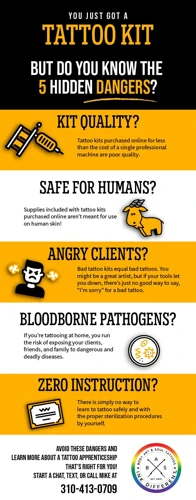
Gather Your Supplies
You will need a tattoo gun, needles, ink, an antiseptic and cotton swabs. Make sure you have all of these materials on hand before you begin.
Choose Your Design
Pick a design that you love and that you are sure of. Make sure you have a clear idea of where you want to place it on your body before you start.
Sanitize the Area
Clean the area where you will be tattooing yourself with an antiseptic. Make sure to use enough disinfectant to ensure that the area is completely clean.
Connect the Gun and Test the Needles
Connect the needles to the tattoo gun and make sure that they are functioning properly. You can test them by pressing the trigger of the gun and testing it on a piece of paper.
Choose Your Ink Color
Choose an ink color that you like and that will work with your design. Make sure to use a high-quality ink that won’t fade or become discolored when it’s exposed to sunlight or water.
Place the Needles in the Gun
Place the needles into the gun and make sure they are securely in place. You can test the needles by pressing the trigger of the gun and testing it on a piece of paper.
Start Tattooing
Start tattooing yourself in small, controlled motions. Start with a light pressure and gradually increase the pressure as you go. Be sure to keep the gun steady and move it in a consistent motion.
Aftercare Tips
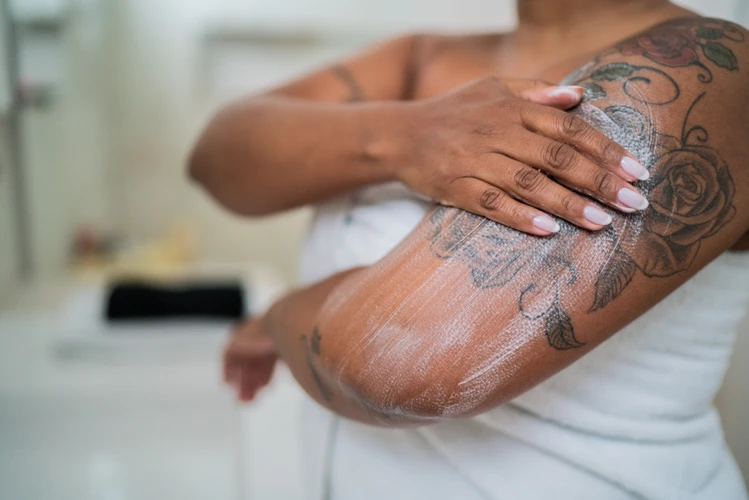
- Clean the area: Clean the area with a mild, unscented soap and warm water to remove any blood, ink, and ointment. Pat dry with a clean cloth.
- Apply a thin layer of ointment: Apply a thin layer of ointment, such as a petroleum-based product. Be sure to avoid any products that contain alcohol or peroxide as these may irritate the skin.
- Keep the area covered: Keep the area covered with a loose bandage or a clean cloth to help protect it from dirt and bacteria. Change the dressing daily.
- Avoid direct sunlight: Avoid direct exposure to the sun as this can cause the tattoo to fade. If you must be in the sun, use a high-SPF sunscreen to protect the area.
- Avoid swimming: Avoid swimming in pools, hot tubs, or any body of water, as this can irritate the area and increase the risk of infection.
- Seek medical attention: Seek medical attention if you experience redness, swelling, or pain in the area or if you develop a fever. These may be signs of infection.
Potential Risks of Tattooing Yourself with a Gun
| Risk | Description |
|---|---|
| Infection | Infection is one of the most common risks associated with tattooing. It is caused by bacteria entering the wound and can cause redness, swelling and pain. |
| Allergic Reactions | Tattoo ink can cause allergic reactions, such as rashes, itchiness, and swelling. If you are sensitive to certain dyes, it is important to do a patch test before getting a tattoo. |
| Scarring | Tattooing can cause scarring, especially if the tattoo is done too deep or too quickly. This can result in the tattoo becoming distorted or faded. |
| Blood-borne Diseases | Tattooing can spread blood-borne diseases such as hepatitis and HIV if the equipment is not sterilized properly. It is important to make sure that the equipment is sterile before beginning the tattoo. |
| Nerve Damage | Tattooing can cause nerve damage if the needle penetrates too deeply. This can result in numbness, tingling, and even permanent paralysis. |
Tattooing can be a great way to express yourself, but it is important to be aware of the potential risks. Before getting a tattoo, it is essential to research the potential risks and to make sure to use sterile equipment.
Frequently Asked Questions
Safety Precautions
- Always use sterilized equipment and needles.
- Use a new pair of disposable gloves and wear them throughout the entire procedure.
- Ensure that the area is clean and disinfected before starting.
- Do a patch test to make sure that you are not allergic to the ink.
- Do not use any ink that has not been specifically designed for tattooing.
- Do not tattoo over any open wounds or broken skin.
- Do not tattoo if you are pregnant or breastfeeding.
- Do not tattoo yourself if you are under the influence of drugs or alcohol.
- Do not use any tattoo machine that is not specifically designed for tattooing.
What Type of Tattoo Gun is Best for a Beginner?
Rotary Tattoo Guns: Rotary tattoo guns are the best type of tattoo gun for beginners. They are lightweight and easy to maneuver, making them perfect for a first-time user. They are also more precise than coil tattoo guns and require less maintenance. They can be used to create both precise lines and shading.
Coil Tattoo Guns: Coil tattoo guns are a great choice for those who are just starting out. They are heavier and more powerful than rotary guns, making them better for larger tattoos or for those who need to work faster. They are also more affordable than rotary guns, making them a great option for those who are just starting out.
Pneumatic Tattoo Guns: Pneumatic tattoo guns are the most powerful type of tattoo gun available. They are ideal for those who need to work quickly and efficiently. However, they are more expensive and require more maintenance, so they are not recommended for beginners.
- Rotary Tattoo Guns: Lightweight and easy to maneuver, more precise than coil tattoo guns and require less maintenance.
- Coil Tattoo Guns: Heavier and more powerful than rotary guns, more affordable than rotary guns.
- Pneumatic Tattoo Guns: Most powerful type of tattoo gun available, ideal for those who need to work quickly and efficiently, more expensive and require more maintenance.
For beginners, a rotary tattoo gun is the best type of tattoo gun to start with. It is lightweight and easy to use, making it perfect for a first-time user. It is also more precise than other types of tattoo guns and requires less maintenance. If you are looking for an affordable option, a coil tattoo gun is a great choice. However, if you need to work quickly and efficiently, a pneumatic tattoo gun is the best option.
How do I make sure the needle is sterile?
- Wash your hands: Wash your hands thoroughly with soap and water before handling the needle.
- Clean the needle: Use alcohol wipes to clean the needle and the surrounding area of the tattoo gun.
- Use a new needle: Make sure to use a new, sterile needle for each tattoo.
- Sterilize the needle: Sterilize the needle using an autoclave or a chemical sterilizer.
How do I choose the design for my tattoo?
Consider Your Motivation: Before settling on a design, ask yourself why you want a tattoo in the first place. Are you looking for something meaningful, something to commemorate an event, or a symbol of your identity? Consider what you want the tattoo to represent and make sure it’s something you’ll still be proud of in the future.
Research Ideas: Look at tattoo galleries online and in magazines to get an idea of what type of designs appeal to you. Make sure to narrow down your search to the kind of tattoo you want, such as a lower back tattoo, a tribal tattoo, or a Celtic knot.
Find a Professional Artist: Once you have an idea of the kind of design you want, find a professional tattoo artist who can help you make it a reality. Talk with the artist about your design and get their advice. You may want to make some modifications or adjustments to the original design to make it unique.
Choose Your Placement: When selecting a design for your tattoo, be sure to consider the placement. Think about how the size and shape of the design will look on the body part you have chosen. For example, a large tribal design will look better on the chest or back than on the arm or ankle.
Think It Through: Remember that a tattoo is permanent, so take your time when deciding on a design. Do your research and make sure you are completely comfortable with the design before getting it tattooed.
What are the Best Practices for Aftercare for a Self-Tattoo?
Clean: After getting a self-tattoo, it is important to clean the area with mild soap and warm water. Pat the area dry with a clean paper towel.
Apply Antibacterial Ointment: Once the area is dry, apply a thin layer of antibacterial ointment. This will help keep the area moist and reduce the risk of infection.
Avoid Sun Exposure: Protect the area from direct sunlight for at least 4 weeks. Sun exposure can cause fading, peeling and discolouration.
Keep the Area Moist: To keep the tattoo looking its best, it is important to keep the area moisturised with a light lotion. This will help keep the skin hydrated and prevent cracking.
Be Gentle: Avoid picking or scratching the area. This can cause damage to the tattoo and lead to infection.
Conclusion
Tattooing yourself with a tattoo gun is a complex process and should not be taken lightly. It is important to be aware of the risks and take necessary safety precautions. To ensure a successful tattoo, it is essential to be patient and take your time while tattooing. With the right knowledge and equipment, you can safely and successfully tattoo yourself.
References
- Kamau, B. (2019, June 15). How to Tattoo Yourself with a Tattoo Gun – A Step-by-Step Guide. https://www.tattooingart.com/how-to-tattoo-yourself-with-a-tattoo-gun/
- Tattoo Gun. (2019, November 21). Wikipedia
- Patel, A. (2018, February 28). How to Sterilize a Tattoo Gun. https://www.tattooingart.com/how-to-sterilize-a-tattoo-gun/